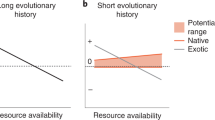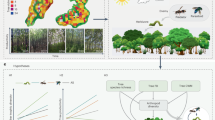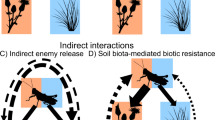Abstract
Herbivores alter plant biodiversity (species richness) in many of the world’s ecosystems, but the magnitude and the direction of herbivore effects on biodiversity vary widely within and among ecosystems. One current theory predicts that herbivores enhance plant biodiversity at high productivity but have the opposite effect at low productivity. Yet, empirical support for the importance of site productivity as a mediator of these herbivore impacts is equivocal. Here, we synthesize data from 252 large-herbivore exclusion studies, spanning a 20-fold range in site productivity, to test an alternative hypothesis—that herbivore-induced changes in the competitive environment determine the response of plant biodiversity to herbivory irrespective of productivity. Under this hypothesis, when herbivores reduce the abundance (biomass, cover) of dominant species (for example, because the dominant plant is palatable), additional resources become available to support new species, thereby increasing biodiversity. By contrast, if herbivores promote high dominance by increasing the abundance of herbivory-resistant, unpalatable species, then resource availability for other species decreases reducing biodiversity. We show that herbivore-induced change in dominance, independent of site productivity or precipitation (a proxy for productivity), is the best predictor of herbivore effects on biodiversity in grassland and savannah sites. Given that most herbaceous ecosystems are dominated by one or a few species, altering the competitive environment via herbivores or by other means may be an effective strategy for conserving biodiversity in grasslands and savannahs globally.
This is a preview of subscription content, access via your institution
Access options
Access Nature and 54 other Nature Portfolio journals
Get Nature+, our best-value online-access subscription
$29.99 / 30 days
cancel any time
Subscribe to this journal
Receive 12 digital issues and online access to articles
$119.00 per year
only $9.92 per issue
Buy this article
- Purchase on Springer Link
- Instant access to full article PDF
Prices may be subject to local taxes which are calculated during checkout




Similar content being viewed by others
Data availability
While not all raw species abundances are publicly available because of lack of permission from data owners (contact individual data set owners listed in Supplementary Table 1), all data generated and analysed during the current study (site-level richness response to herbivory, site-level Berger–Parker and Simpson’s dominance response to herbivory, site ANPP, and site MAP) are provided in Supplementary Table 2.
References
Estes, J. A. et al. Trophic downgrading of planet Earth. Science 333, 301–306 (2011).
Bakker, E. S., Ritchie, M. E., Olff, H., Milchunas, D. G. & Knops, J. M. H. Herbivore impact on grassland plant diversity depends on habitat productivity and herbivore size. Ecol. Lett. 9, 780–788 (2006).
Proulx, M. & Mazumder, A. Reversal of grazing impact on plant species richness in nutrient-poor vs. nutrient-rich ecosystems. Ecology 79, 2581–2592 (1998).
Worm, B., Lotze, H. K., Hillebrand, H. & Sommer, U. Consumer versus resource control of species diversity and ecosystem functioning. Nature 417, 848–851 (2002).
Borer, E. T. et al. Herbivores and nutrients control grassland plant diversity via light limitation. Nature 508, 517–520 (2014).
Hillebrand, H. et al. Consumer versus resource control of producer diversity depends on ecosystem type and producer community structure. Proc. Natl Acad. Sci. USA 104, 10904–10909 (2007).
Olff, H. & Ritchie, M. E. Effects of herbivores on grassland plant diversity. Trends Ecol. Evol. 13, 261–265 (1998).
Osem, Y., Perevolotsky, A. & Kigel, J. Grazing effect on diversity of annual plant communities in a semi-arid rangeland: interactions with small-scale spatial and temporal variation in primary productivity. J. Ecol. 90, 936–946 (2002).
Lezama, F. et al. Variation of grazing-induced vegetation changes across a large-scale productivity gradient. J. Veg. Sci. 25, 8–21 (2014).
Frank, D. A., McNaughton, S. J. & Tracy, B. F. The ecology of the Earth’s grazing ecosystems. BioScience 48, 513–521 (1998).
McNaughton, S. J. & Wolf, L. L. Dominance and the niche in ecological systems. Science 167, 131–139 (1970).
Koerner, S. E. et al. Plant community response to loss of large herbivores differs between North American and South African savanna grasslands. Ecology 95, 808–816 (2014).
Milchunas, D. G. & Lauenroth, W. K. Quantitative effects of grazing on vegetation and soils over a global range of environments. Ecol. Monogr. 63, 327–366 (1993).
Eldridge, D. J., Poore, A. G. B., Ruiz-Colmenero, M., Letnic, M. & Soliveres, S. Ecosystem structure, function, and composition in rangelands are negatively affected by livestock grazing. Ecol. Appl. 26, 1273–1283 (2016).
Smith, M. D. & Knapp, A. K. Dominant species maintain ecosystem function with non-random species loss. Ecol. Lett. 6, 509–517 (2003).
Collins, S. L. & Xia, Y. Long-term dynamics and hotspots of change in a desert grassland plant community. Am. Nat. 185, E30–E43 (2015).
Olson, D. M. et al. Terrestrial ecoregions of the world: a new map of life on Earth. BioScience 51, 933–938 (2001).
Magurran, A. E. Measuring Biological Diversity (Wiley-Blackwell, New York, 2013)..
Smith, B. & Wilson, J B. A consumer’s guide to evenness indices. Oikos 76, 70–82 (1996).
Sala, O. E., Gherardi, L. A., Reichmann, L., Jobbágy, E. & Peters, D. Legacies of precipitation fluctuations on primary production: theory and data synthesis. Phil. Trans. R. Soc. B 367, 3135–3144 (2012).
Forrestel, E. J. et al. Different clades and traits yield similar grassland functional responses. Proc. Natl Acad. Sci. USA 114, 705–710 (2017).
Grime, J. P. Benefits of plant diversity to ecosystems: immediate, filter and founder effects. J. Ecol. 86, 902–910 (1998).
Grace, J. B. et al. Integrative modelling reveals mechanisms linking productivity and plant species richness. Nature 529, 390–393 (2016).
Eby, S. et al. Loss of a large grazer impacts savanna grassland plant communities similarly in North America and South Africa. Oecologia 175, 293–303 (2014).
Burkepile, D. E. et al. Fire frequency drives habitat selection by a diverse herbivore guild impacting top-down control of plant communities in an African savanna. Oikos 125, 1636–1646 (2016).
Collins, S. L., Knapp, A. K., Briggs, J. M., Blair, J. M. & Steinauer, E. M. Modulation of diversity by grazing and mowing in native tallgrass prairie. Science 280, 745–747 (1998).
McNaughton, S. J. Serengeti grassland ecology: the role of composite environmental factors and contingency in community organization. Ecol. Monogr. 53, 291–320 (1983).
Plas, F., Howison, R. A., Mpanza, N., Cromsigt, J. P. G. M. & Olff, H. Different‐sized grazers have distinctive effects on plant functional composition of an African savannah. J. Ecol. 104, 864–875 (2016).
Whittaker, R. H. Dominance and diversity in land plant communities: numerical relations of species express the importance of competition in community function and evolution. Science 147, 250–260 (1965).
Smith, M. D., Wilcox, J. C., Kelly, T. & Knapp, A. K. Dominance not richness determines invasibility of tallgrass prairie. Oikos 106, 253–262 (2004).
Milchunas, D. G., Sala, O. E. & Lauenroth, W. K. A generalized model of the effects of grazing by large herbivores on grassland community structure. Am. Nat. 132, 87–106 (1988).
Yang, Z. et al. Daytime warming lowers community temporal stability by reducing the abundance of dominant, stable species. Glob. Change Biol. 23, 154–163 (2017).
Hijmans, R. J., Cameron, S. E., Parra, J. L., Jones, P. G. & Jarvis, A. Very high resolution interpolated climate surfaces for global land areas. Int. J. Climatol. 25, 1965–1978 (2005).
Acknowledgements
Funding for this synthesis was provided for by USDA AFRI Foundational Conference Grant (award no. 2018-67013-27400). We would like to thank the National Evolutionary Synthesis Center (Grasslands Working Group), the School of Global Environmental Sustainability at Colorado State University and the National Center for Ecological Analysis and Synthesis for hosting working meetings that led to these analyses. We also thank M. Ritchie, D. Augustine and R. Pringle for helpful comments on an earlier version of the manuscript. Any use of trade, firm or product names is for descriptive purposes only and does not imply endorsement by the U.S. Government. Individual sites acknowledge funding support: Kenya Long-term Exclosure Experiment—NFS DEB 12-56004; Jornada—NSF DEB-0618210; Konza Prairie and Kruger National Park—NSF DEB 0841917; Kruger National Park—NSF DEB 1712786.
Author information
Authors and Affiliations
Contributions
S.E.K. managed the project including conceptualizing the questions, collecting and analysing the data, developing the figures and writing the manuscript. M.D.S. conceptualized the questions and wrote the manuscript. D.E.B. conceptualized the questions, collected the data and wrote the manuscript. N.P.H. performed simulations and wrote the manuscript. M.L.A. and N.P.L. executed the path analyses and developed the figures. S.L.C. and A.K.K. wrote the manuscript. S.E., E.J.F. and D.I.T. contributed to data collection and management. S.E.K., M.D.S., D.E.B., N.P.H., M.L.A., S.L.C., A.K.K., N.P.L., E.J.F., S.E. and D.I.T. attended multiple working groups to complete this manuscript while all other co-authors contributed data to the synthesis; all authors (both members of the working group and not) edited the manuscript. See the author contribution table (Supplementary Table 11) for a complete list of contributions.
Corresponding author
Ethics declarations
Competing interests
The authors declare no competing interests.
Additional information
Publisher’s note: Springer Nature remains neutral with regard to jurisdictional claims in published maps and institutional affiliations.
Supplementary information
Supplementary Information
Supplementary Figures 1–4 and Supplementary Tables 1–10
Supplementary Table 11
Detailed list of author contributions
Rights and permissions
About this article
Cite this article
Koerner, S.E., Smith, M.D., Burkepile, D.E. et al. Change in dominance determines herbivore effects on plant biodiversity. Nat Ecol Evol 2, 1925–1932 (2018). https://doi.org/10.1038/s41559-018-0696-y
Received:
Accepted:
Published:
Issue Date:
DOI: https://doi.org/10.1038/s41559-018-0696-y
This article is cited by
-
Historical impacts of grazing on carbon stocks and climate mitigation opportunities
Nature Climate Change (2024)
-
Trade-offs between deer herbivory and nitrogen competition alter grassland forb composition
Oecologia (2024)
-
Grazing effects on vegetation dynamics in the savannah ecosystems of the Sahel
Ecological Processes (2023)
-
Ecovoltaic principles for a more sustainable, ecologically informed solar energy future
Nature Ecology & Evolution (2023)
-
Megaherbivores provide biotic resistance against alien plant dominance
Nature Ecology & Evolution (2023)



